Detailed Networking Report: Design, Implementation and Maintenance
VerifiedAdded on 2024/05/21
|39
|4643
|493
Report
AI Summary
This report provides a comprehensive overview of computer networking, covering fundamental aspects such as network types (peer-to-peer, client-server, PAN, LAN, WAN, MAN), network topologies (bus, ring, star, mesh), and essential networking principles. It discusses the benefits and constraints of different network types and standards, explaining the impact of network topology, communication, and bandwidth requirements. The report also compares common networking principles and how protocols enable the effectiveness of networked systems. Furthermore, it delves into the operating principles of networking devices and server types (file, print, mail, web, database), justifying the selection of specific servers for a given scenario based on cost and performance optimization. The document includes a network design to meet specified requirements, along with testing and evaluation results, user feedback analysis, and a maintenance schedule. It also addresses the implementation of a networked system, documentation of test results, and recommendations for potential system enhancements, concluding with a critical reflection on the work and valid conclusions. Desklib offers this and many other solved assignments to help students excel.

NETWORKING
Paraphrase This Document
Need a fresh take? Get an instant paraphrase of this document with our AI Paraphraser
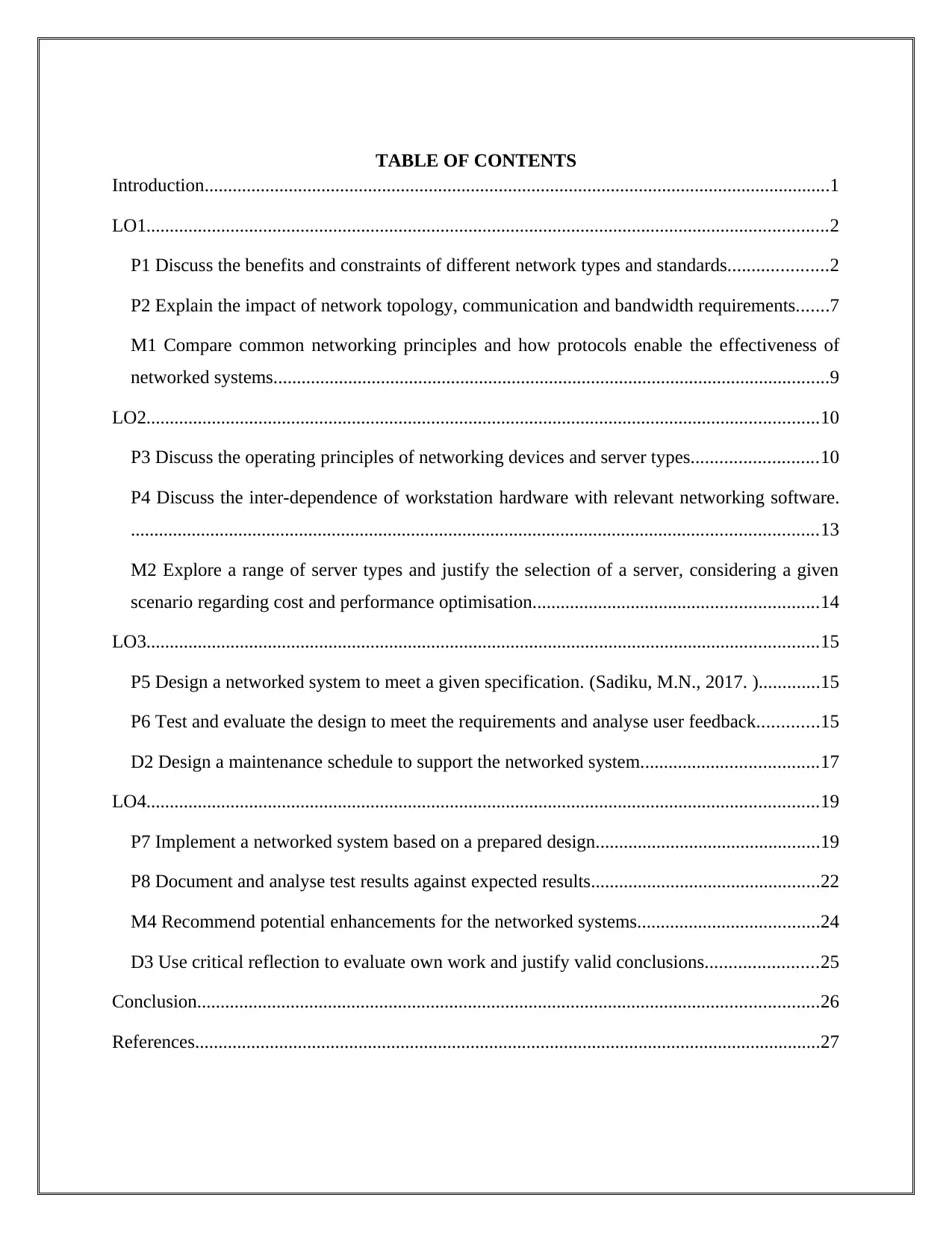
TABLE OF CONTENTS
Introduction......................................................................................................................................1
LO1..................................................................................................................................................2
P1 Discuss the benefits and constraints of different network types and standards.....................2
P2 Explain the impact of network topology, communication and bandwidth requirements.......7
M1 Compare common networking principles and how protocols enable the effectiveness of
networked systems.......................................................................................................................9
LO2................................................................................................................................................10
P3 Discuss the operating principles of networking devices and server types...........................10
P4 Discuss the inter-dependence of workstation hardware with relevant networking software.
...................................................................................................................................................13
M2 Explore a range of server types and justify the selection of a server, considering a given
scenario regarding cost and performance optimisation.............................................................14
LO3................................................................................................................................................15
P5 Design a networked system to meet a given specification. (Sadiku, M.N., 2017. ).............15
P6 Test and evaluate the design to meet the requirements and analyse user feedback.............15
D2 Design a maintenance schedule to support the networked system......................................17
LO4................................................................................................................................................19
P7 Implement a networked system based on a prepared design................................................19
P8 Document and analyse test results against expected results.................................................22
M4 Recommend potential enhancements for the networked systems.......................................24
D3 Use critical reflection to evaluate own work and justify valid conclusions........................25
Conclusion.....................................................................................................................................26
References......................................................................................................................................27
Introduction......................................................................................................................................1
LO1..................................................................................................................................................2
P1 Discuss the benefits and constraints of different network types and standards.....................2
P2 Explain the impact of network topology, communication and bandwidth requirements.......7
M1 Compare common networking principles and how protocols enable the effectiveness of
networked systems.......................................................................................................................9
LO2................................................................................................................................................10
P3 Discuss the operating principles of networking devices and server types...........................10
P4 Discuss the inter-dependence of workstation hardware with relevant networking software.
...................................................................................................................................................13
M2 Explore a range of server types and justify the selection of a server, considering a given
scenario regarding cost and performance optimisation.............................................................14
LO3................................................................................................................................................15
P5 Design a networked system to meet a given specification. (Sadiku, M.N., 2017. ).............15
P6 Test and evaluate the design to meet the requirements and analyse user feedback.............15
D2 Design a maintenance schedule to support the networked system......................................17
LO4................................................................................................................................................19
P7 Implement a networked system based on a prepared design................................................19
P8 Document and analyse test results against expected results.................................................22
M4 Recommend potential enhancements for the networked systems.......................................24
D3 Use critical reflection to evaluate own work and justify valid conclusions........................25
Conclusion.....................................................................................................................................26
References......................................................................................................................................27

LIST OF TABLES
Table 1: Benefit and constraints of peer-to-peer and client server network....................................3
Table 2: Benefits and Constraints of different network types.........................................................4
Table 3: maintenance schedule......................................................................................................17
Table 4: Test result when compared between expected and attained result of the network design
.......................................................................................................................................................22
Table 1: Benefit and constraints of peer-to-peer and client server network....................................3
Table 2: Benefits and Constraints of different network types.........................................................4
Table 3: maintenance schedule......................................................................................................17
Table 4: Test result when compared between expected and attained result of the network design
.......................................................................................................................................................22
⊘ This is a preview!⊘
Do you want full access?
Subscribe today to unlock all pages.

Trusted by 1+ million students worldwide
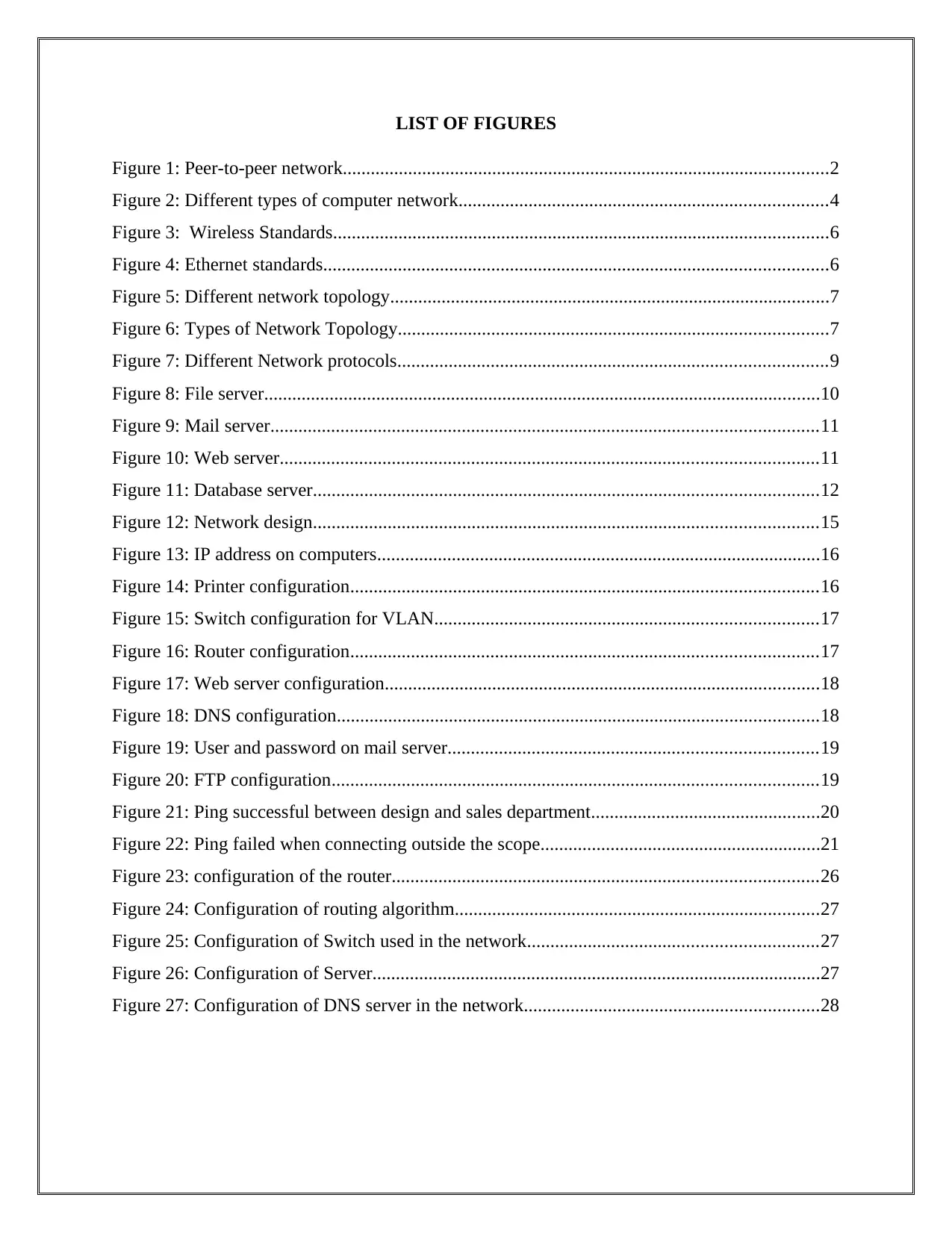
LIST OF FIGURES
Figure 1: Peer-to-peer network........................................................................................................2
Figure 2: Different types of computer network...............................................................................4
Figure 3: Wireless Standards..........................................................................................................6
Figure 4: Ethernet standards............................................................................................................6
Figure 5: Different network topology..............................................................................................7
Figure 6: Types of Network Topology............................................................................................7
Figure 7: Different Network protocols............................................................................................9
Figure 8: File server.......................................................................................................................10
Figure 9: Mail server.....................................................................................................................11
Figure 10: Web server...................................................................................................................11
Figure 11: Database server............................................................................................................12
Figure 12: Network design............................................................................................................15
Figure 13: IP address on computers...............................................................................................16
Figure 14: Printer configuration....................................................................................................16
Figure 15: Switch configuration for VLAN..................................................................................17
Figure 16: Router configuration....................................................................................................17
Figure 17: Web server configuration.............................................................................................18
Figure 18: DNS configuration.......................................................................................................18
Figure 19: User and password on mail server...............................................................................19
Figure 20: FTP configuration........................................................................................................19
Figure 21: Ping successful between design and sales department.................................................20
Figure 22: Ping failed when connecting outside the scope............................................................21
Figure 23: configuration of the router...........................................................................................26
Figure 24: Configuration of routing algorithm..............................................................................27
Figure 25: Configuration of Switch used in the network..............................................................27
Figure 26: Configuration of Server................................................................................................27
Figure 27: Configuration of DNS server in the network...............................................................28
Figure 1: Peer-to-peer network........................................................................................................2
Figure 2: Different types of computer network...............................................................................4
Figure 3: Wireless Standards..........................................................................................................6
Figure 4: Ethernet standards............................................................................................................6
Figure 5: Different network topology..............................................................................................7
Figure 6: Types of Network Topology............................................................................................7
Figure 7: Different Network protocols............................................................................................9
Figure 8: File server.......................................................................................................................10
Figure 9: Mail server.....................................................................................................................11
Figure 10: Web server...................................................................................................................11
Figure 11: Database server............................................................................................................12
Figure 12: Network design............................................................................................................15
Figure 13: IP address on computers...............................................................................................16
Figure 14: Printer configuration....................................................................................................16
Figure 15: Switch configuration for VLAN..................................................................................17
Figure 16: Router configuration....................................................................................................17
Figure 17: Web server configuration.............................................................................................18
Figure 18: DNS configuration.......................................................................................................18
Figure 19: User and password on mail server...............................................................................19
Figure 20: FTP configuration........................................................................................................19
Figure 21: Ping successful between design and sales department.................................................20
Figure 22: Ping failed when connecting outside the scope............................................................21
Figure 23: configuration of the router...........................................................................................26
Figure 24: Configuration of routing algorithm..............................................................................27
Figure 25: Configuration of Switch used in the network..............................................................27
Figure 26: Configuration of Server................................................................................................27
Figure 27: Configuration of DNS server in the network...............................................................28
Paraphrase This Document
Need a fresh take? Get an instant paraphrase of this document with our AI Paraphraser
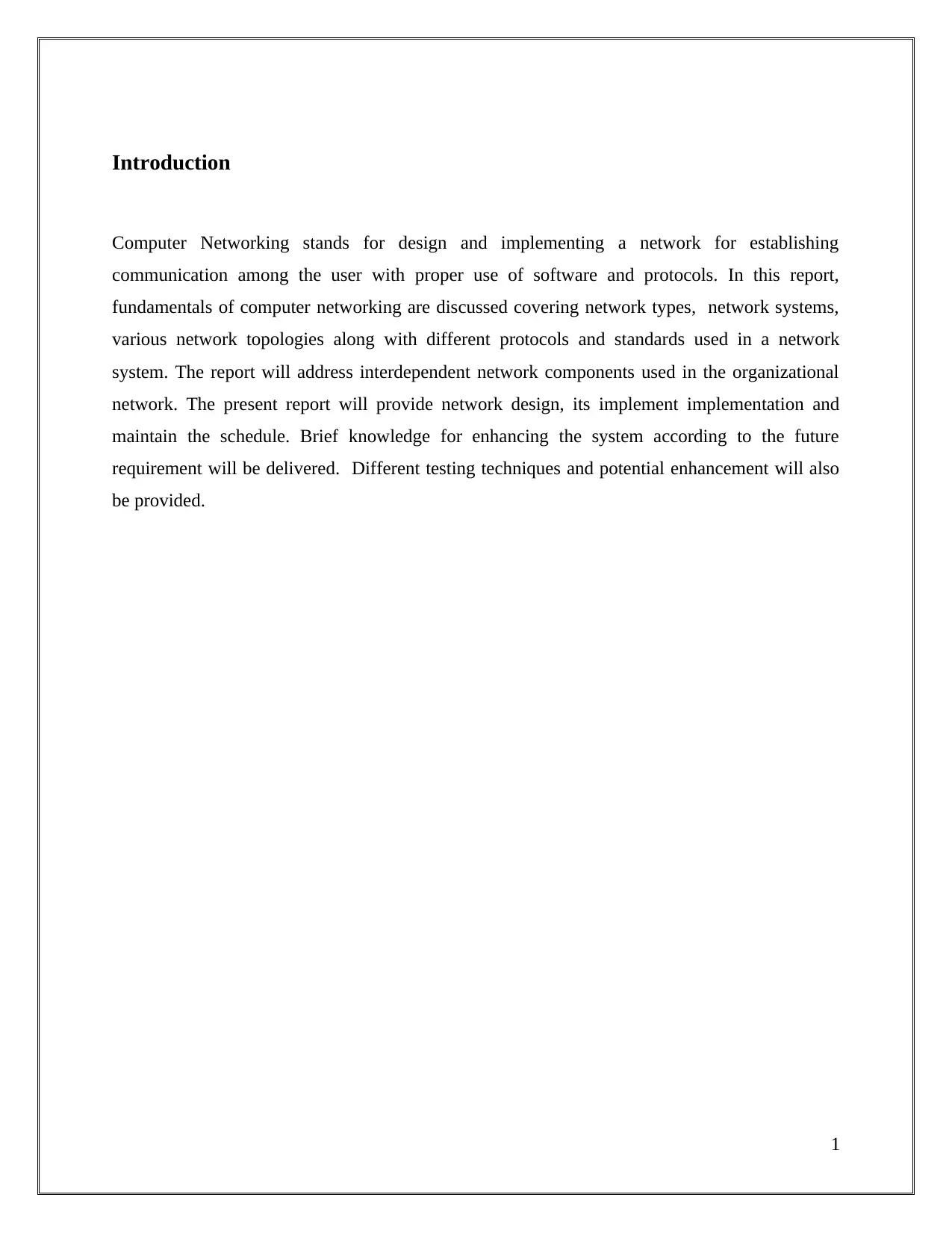
Introduction
Computer Networking stands for design and implementing a network for establishing
communication among the user with proper use of software and protocols. In this report,
fundamentals of computer networking are discussed covering network types, network systems,
various network topologies along with different protocols and standards used in a network
system. The report will address interdependent network components used in the organizational
network. The present report will provide network design, its implement implementation and
maintain the schedule. Brief knowledge for enhancing the system according to the future
requirement will be delivered. Different testing techniques and potential enhancement will also
be provided.
1
Computer Networking stands for design and implementing a network for establishing
communication among the user with proper use of software and protocols. In this report,
fundamentals of computer networking are discussed covering network types, network systems,
various network topologies along with different protocols and standards used in a network
system. The report will address interdependent network components used in the organizational
network. The present report will provide network design, its implement implementation and
maintain the schedule. Brief knowledge for enhancing the system according to the future
requirement will be delivered. Different testing techniques and potential enhancement will also
be provided.
1

LO1
P1 Discuss the benefits and constraints of different network types and standards.
Network System
Peer-to-peer and client-server are computer system architecture that applies to some types of
businesses.
Peer-to-peer network
In this network model same workgroup is used for connecting the system using unique names.
The primary purpose of this network is to share resources in minimum expense.
Figure 1: Peer-to-peer network
(Source: )
Client-server network
This kind of network has two logical parts a server and a client. Here the workstations are
referred as clients that can access file which is stored on the server. The network has centralized
database that controls the access of resources.
2
P1 Discuss the benefits and constraints of different network types and standards.
Network System
Peer-to-peer and client-server are computer system architecture that applies to some types of
businesses.
Peer-to-peer network
In this network model same workgroup is used for connecting the system using unique names.
The primary purpose of this network is to share resources in minimum expense.
Figure 1: Peer-to-peer network
(Source: )
Client-server network
This kind of network has two logical parts a server and a client. Here the workstations are
referred as clients that can access file which is stored on the server. The network has centralized
database that controls the access of resources.
2
⊘ This is a preview!⊘
Do you want full access?
Subscribe today to unlock all pages.

Trusted by 1+ million students worldwide

Table 1: Benefit and constraints of peer-to-peer and client server network
Peer-to-peer network Client-server network
Benefit: This type of network is very easy to
be set. Expense for network maintenance is
low. Dependency of the network is low, and
cost of Server is not present
Benefit: In Client-server network architecture
a Centralised backup system can be
attainable. Therefore network security is
maintained and fast resource sharing is
possible with central administration.
Constraints: Due to lack of centralised server
complexities arises while data backup. In
peer-to-peer network security is fragile.
Constraints: Main drawback of in
implementing this network is related to cost
factor. The network demands a server with
sufficiently large memory space.
Recommendation- The organisation can opt for implementing a client-server network system so
that all the devices and resources in the network can be effectively managed and controlled with
proper communication.
Network Types
Computer network technology supports various different types of network structure for
connecting the devices in the networks according to size and scalability. PAN, LAN, WAN and
MAN are he most common network types.
3
Peer-to-peer network Client-server network
Benefit: This type of network is very easy to
be set. Expense for network maintenance is
low. Dependency of the network is low, and
cost of Server is not present
Benefit: In Client-server network architecture
a Centralised backup system can be
attainable. Therefore network security is
maintained and fast resource sharing is
possible with central administration.
Constraints: Due to lack of centralised server
complexities arises while data backup. In
peer-to-peer network security is fragile.
Constraints: Main drawback of in
implementing this network is related to cost
factor. The network demands a server with
sufficiently large memory space.
Recommendation- The organisation can opt for implementing a client-server network system so
that all the devices and resources in the network can be effectively managed and controlled with
proper communication.
Network Types
Computer network technology supports various different types of network structure for
connecting the devices in the networks according to size and scalability. PAN, LAN, WAN and
MAN are he most common network types.
3
Paraphrase This Document
Need a fresh take? Get an instant paraphrase of this document with our AI Paraphraser
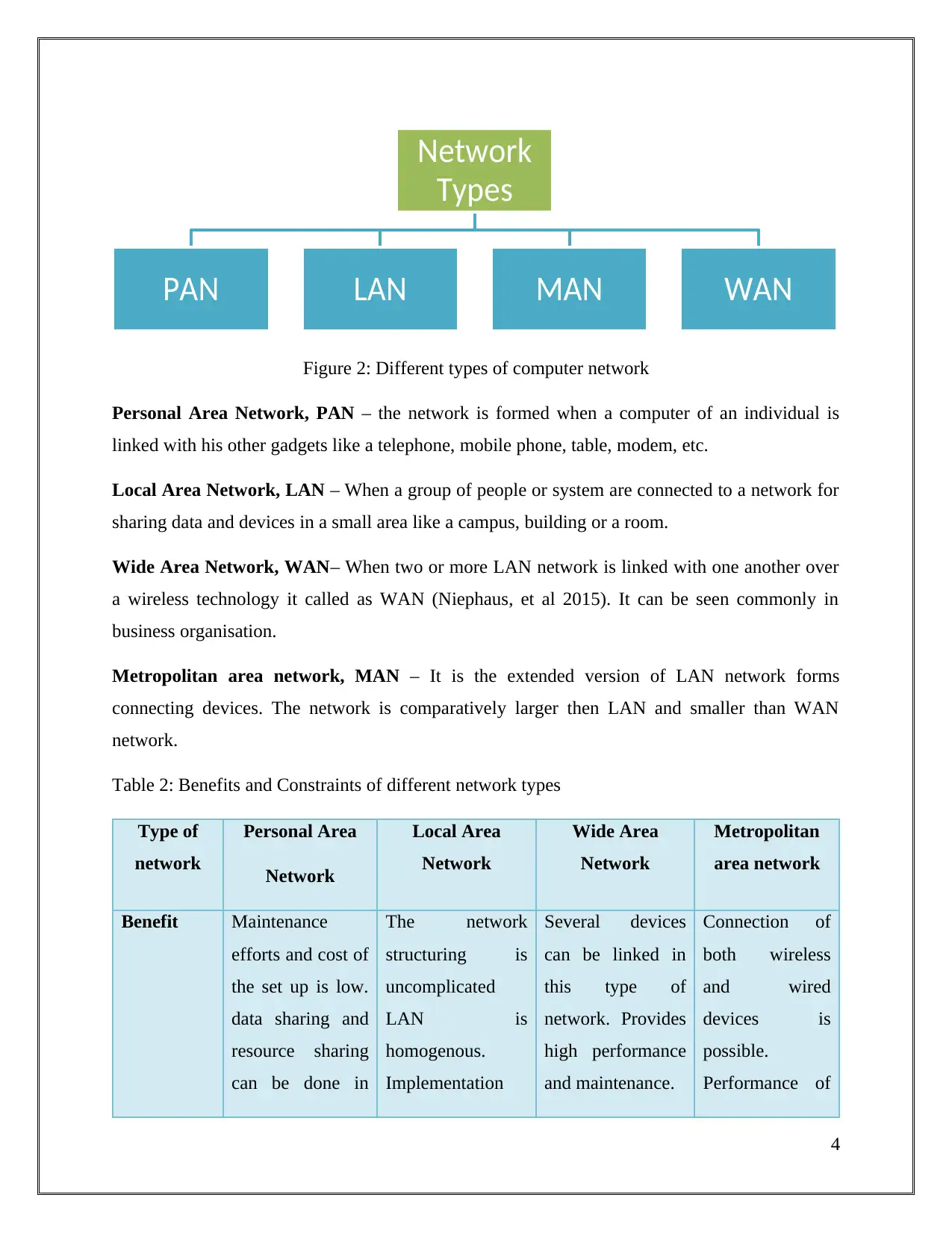
Figure 2: Different types of computer network
Personal Area Network, PAN – the network is formed when a computer of an individual is
linked with his other gadgets like a telephone, mobile phone, table, modem, etc.
Local Area Network, LAN – When a group of people or system are connected to a network for
sharing data and devices in a small area like a campus, building or a room.
Wide Area Network, WAN– When two or more LAN network is linked with one another over
a wireless technology it called as WAN (Niephaus, et al 2015). It can be seen commonly in
business organisation.
Metropolitan area network, MAN – It is the extended version of LAN network forms
connecting devices. The network is comparatively larger then LAN and smaller than WAN
network.
Table 2: Benefits and Constraints of different network types
Type of
network
Personal Area
Network
Local Area
Network
Wide Area
Network
Metropolitan
area network
Benefit Maintenance
efforts and cost of
the set up is low.
data sharing and
resource sharing
can be done in
The network
structuring is
uncomplicated
LAN is
homogenous.
Implementation
Several devices
can be linked in
this type of
network. Provides
high performance
and maintenance.
Connection of
both wireless
and wired
devices is
possible.
Performance of
4
Network
Types
PAN LAN MAN WAN
Personal Area Network, PAN – the network is formed when a computer of an individual is
linked with his other gadgets like a telephone, mobile phone, table, modem, etc.
Local Area Network, LAN – When a group of people or system are connected to a network for
sharing data and devices in a small area like a campus, building or a room.
Wide Area Network, WAN– When two or more LAN network is linked with one another over
a wireless technology it called as WAN (Niephaus, et al 2015). It can be seen commonly in
business organisation.
Metropolitan area network, MAN – It is the extended version of LAN network forms
connecting devices. The network is comparatively larger then LAN and smaller than WAN
network.
Table 2: Benefits and Constraints of different network types
Type of
network
Personal Area
Network
Local Area
Network
Wide Area
Network
Metropolitan
area network
Benefit Maintenance
efforts and cost of
the set up is low.
data sharing and
resource sharing
can be done in
The network
structuring is
uncomplicated
LAN is
homogenous.
Implementation
Several devices
can be linked in
this type of
network. Provides
high performance
and maintenance.
Connection of
both wireless
and wired
devices is
possible.
Performance of
4
Network
Types
PAN LAN MAN WAN
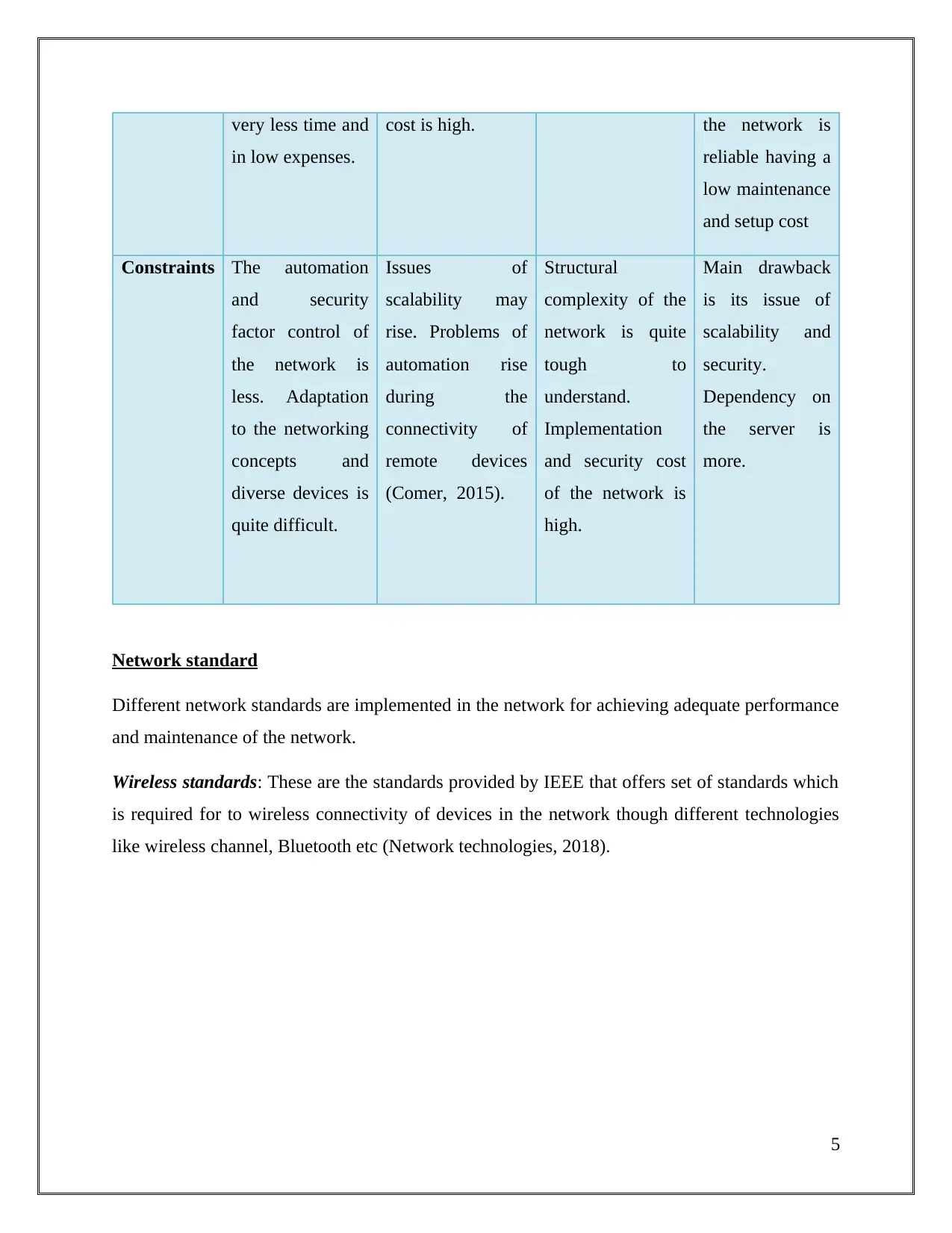
very less time and
in low expenses.
cost is high. the network is
reliable having a
low maintenance
and setup cost
Constraints The automation
and security
factor control of
the network is
less. Adaptation
to the networking
concepts and
diverse devices is
quite difficult.
Issues of
scalability may
rise. Problems of
automation rise
during the
connectivity of
remote devices
(Comer, 2015).
Structural
complexity of the
network is quite
tough to
understand.
Implementation
and security cost
of the network is
high.
Main drawback
is its issue of
scalability and
security.
Dependency on
the server is
more.
Network standard
Different network standards are implemented in the network for achieving adequate performance
and maintenance of the network.
Wireless standards: These are the standards provided by IEEE that offers set of standards which
is required for to wireless connectivity of devices in the network though different technologies
like wireless channel, Bluetooth etc (Network technologies, 2018).
5
in low expenses.
cost is high. the network is
reliable having a
low maintenance
and setup cost
Constraints The automation
and security
factor control of
the network is
less. Adaptation
to the networking
concepts and
diverse devices is
quite difficult.
Issues of
scalability may
rise. Problems of
automation rise
during the
connectivity of
remote devices
(Comer, 2015).
Structural
complexity of the
network is quite
tough to
understand.
Implementation
and security cost
of the network is
high.
Main drawback
is its issue of
scalability and
security.
Dependency on
the server is
more.
Network standard
Different network standards are implemented in the network for achieving adequate performance
and maintenance of the network.
Wireless standards: These are the standards provided by IEEE that offers set of standards which
is required for to wireless connectivity of devices in the network though different technologies
like wireless channel, Bluetooth etc (Network technologies, 2018).
5
⊘ This is a preview!⊘
Do you want full access?
Subscribe today to unlock all pages.

Trusted by 1+ million students worldwide
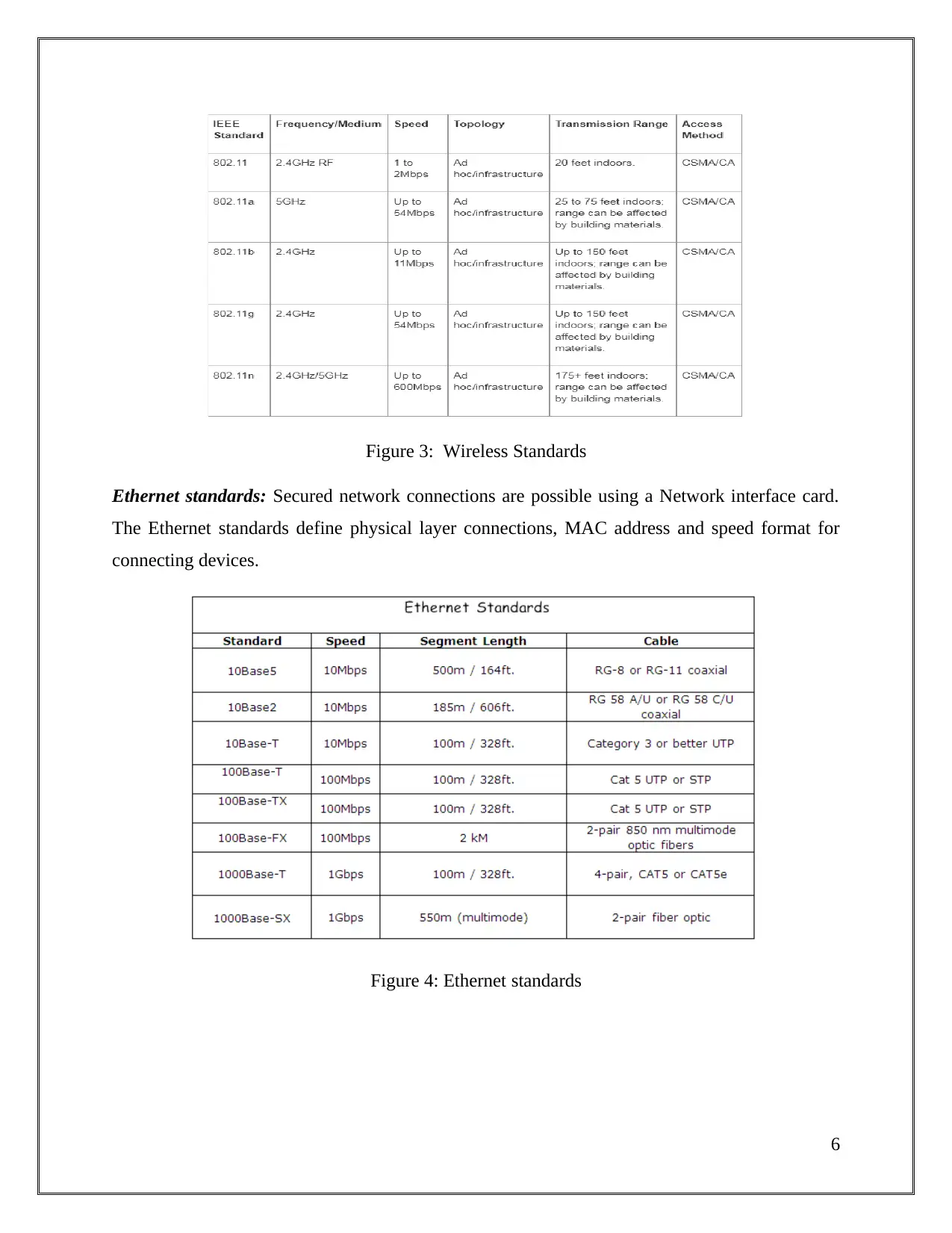
Figure 3: Wireless Standards
Ethernet standards: Secured network connections are possible using a Network interface card.
The Ethernet standards define physical layer connections, MAC address and speed format for
connecting devices.
Figure 4: Ethernet standards
6
Ethernet standards: Secured network connections are possible using a Network interface card.
The Ethernet standards define physical layer connections, MAC address and speed format for
connecting devices.
Figure 4: Ethernet standards
6
Paraphrase This Document
Need a fresh take? Get an instant paraphrase of this document with our AI Paraphraser
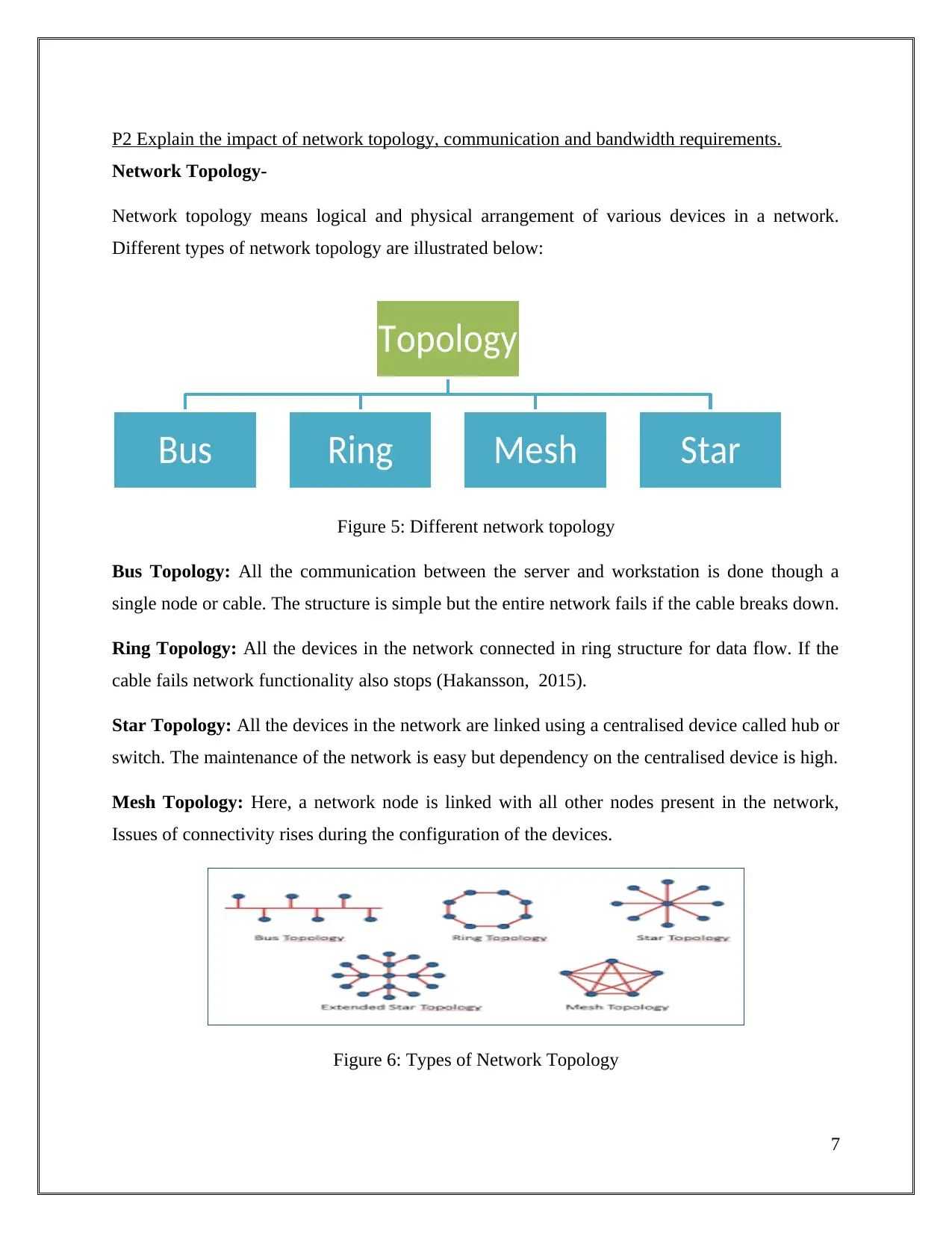
P2 Explain the impact of network topology, communication and bandwidth requirements.
Network Topology-
Network topology means logical and physical arrangement of various devices in a network.
Different types of network topology are illustrated below:
Figure 5: Different network topology
Bus Topology: All the communication between the server and workstation is done though a
single node or cable. The structure is simple but the entire network fails if the cable breaks down.
Ring Topology: All the devices in the network connected in ring structure for data flow. If the
cable fails network functionality also stops (Hakansson, 2015).
Star Topology: All the devices in the network are linked using a centralised device called hub or
switch. The maintenance of the network is easy but dependency on the centralised device is high.
Mesh Topology: Here, a network node is linked with all other nodes present in the network,
Issues of connectivity rises during the configuration of the devices.
Figure 6: Types of Network Topology
7
Topology
Bus Ring Mesh Star
Network Topology-
Network topology means logical and physical arrangement of various devices in a network.
Different types of network topology are illustrated below:
Figure 5: Different network topology
Bus Topology: All the communication between the server and workstation is done though a
single node or cable. The structure is simple but the entire network fails if the cable breaks down.
Ring Topology: All the devices in the network connected in ring structure for data flow. If the
cable fails network functionality also stops (Hakansson, 2015).
Star Topology: All the devices in the network are linked using a centralised device called hub or
switch. The maintenance of the network is easy but dependency on the centralised device is high.
Mesh Topology: Here, a network node is linked with all other nodes present in the network,
Issues of connectivity rises during the configuration of the devices.
Figure 6: Types of Network Topology
7
Topology
Bus Ring Mesh Star
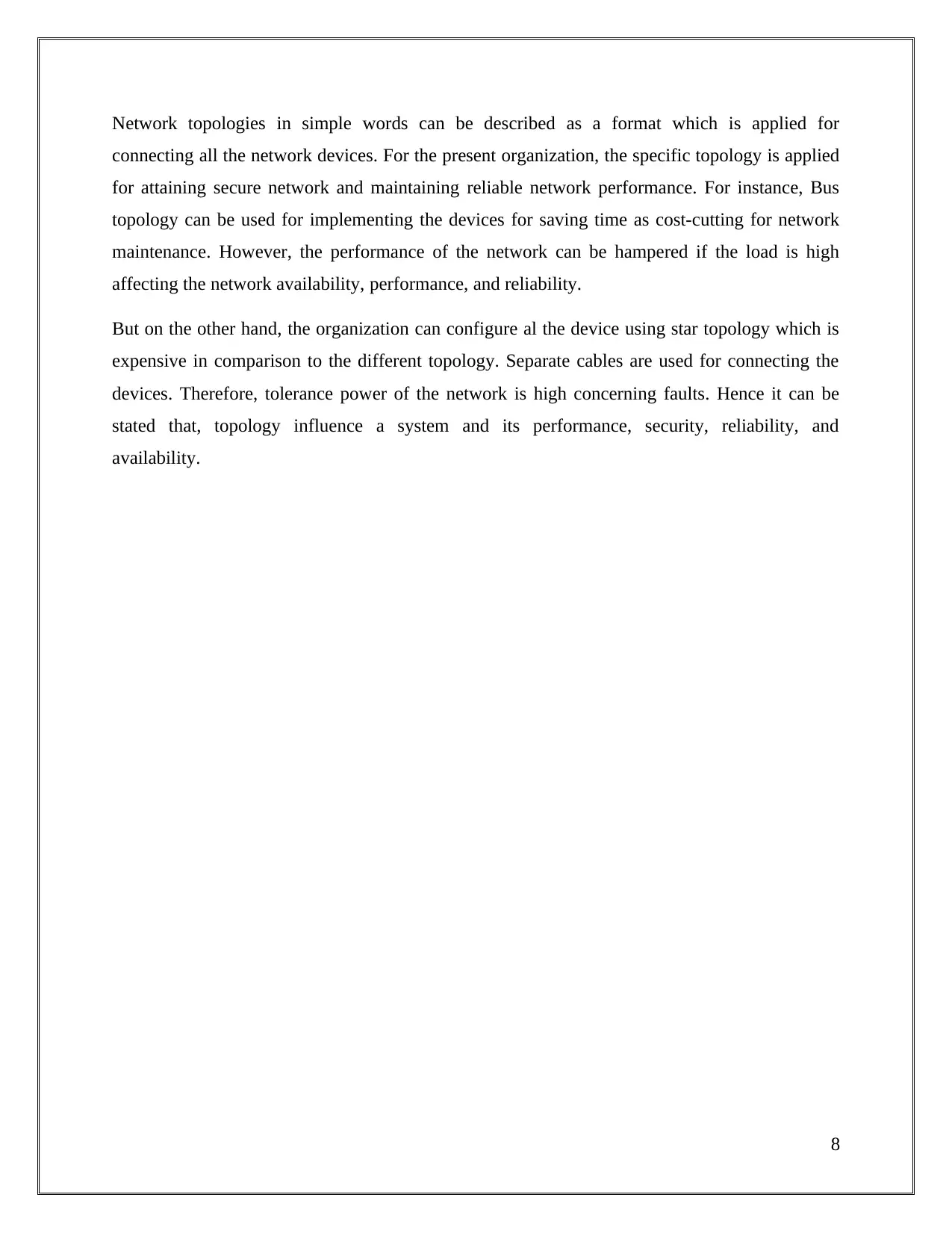
Network topologies in simple words can be described as a format which is applied for
connecting all the network devices. For the present organization, the specific topology is applied
for attaining secure network and maintaining reliable network performance. For instance, Bus
topology can be used for implementing the devices for saving time as cost-cutting for network
maintenance. However, the performance of the network can be hampered if the load is high
affecting the network availability, performance, and reliability.
But on the other hand, the organization can configure al the device using star topology which is
expensive in comparison to the different topology. Separate cables are used for connecting the
devices. Therefore, tolerance power of the network is high concerning faults. Hence it can be
stated that, topology influence a system and its performance, security, reliability, and
availability.
8
connecting all the network devices. For the present organization, the specific topology is applied
for attaining secure network and maintaining reliable network performance. For instance, Bus
topology can be used for implementing the devices for saving time as cost-cutting for network
maintenance. However, the performance of the network can be hampered if the load is high
affecting the network availability, performance, and reliability.
But on the other hand, the organization can configure al the device using star topology which is
expensive in comparison to the different topology. Separate cables are used for connecting the
devices. Therefore, tolerance power of the network is high concerning faults. Hence it can be
stated that, topology influence a system and its performance, security, reliability, and
availability.
8
⊘ This is a preview!⊘
Do you want full access?
Subscribe today to unlock all pages.

Trusted by 1+ million students worldwide
1 out of 39
Related Documents
Your All-in-One AI-Powered Toolkit for Academic Success.
+13062052269
info@desklib.com
Available 24*7 on WhatsApp / Email
![[object Object]](/_next/static/media/star-bottom.7253800d.svg)
Unlock your academic potential
Copyright © 2020–2025 A2Z Services. All Rights Reserved. Developed and managed by ZUCOL.



